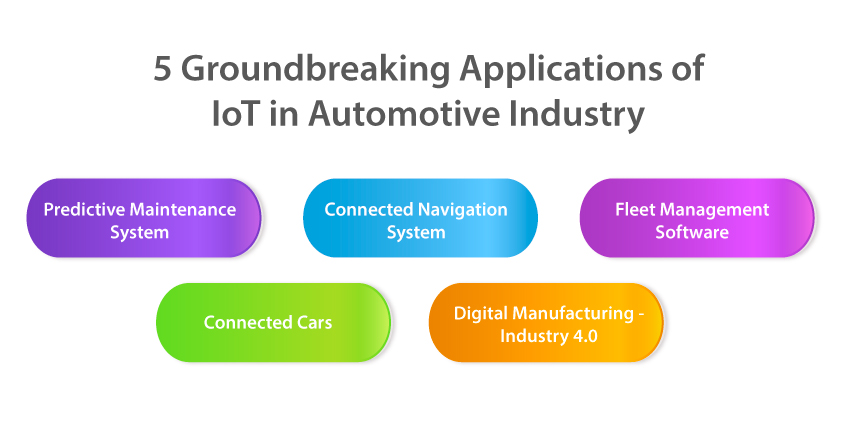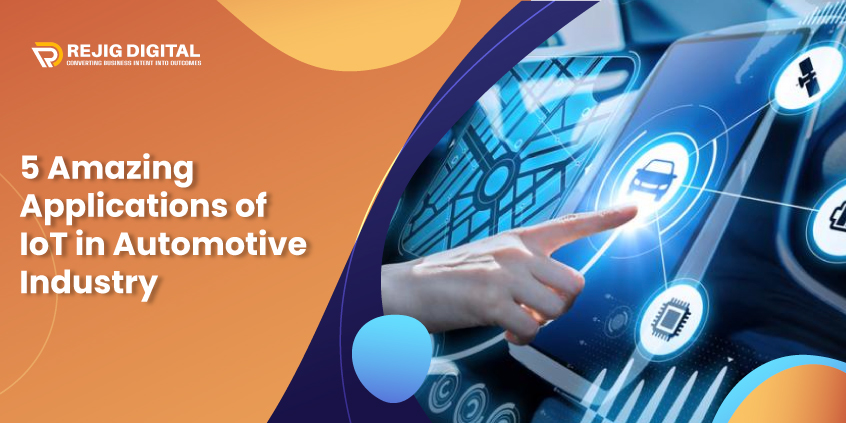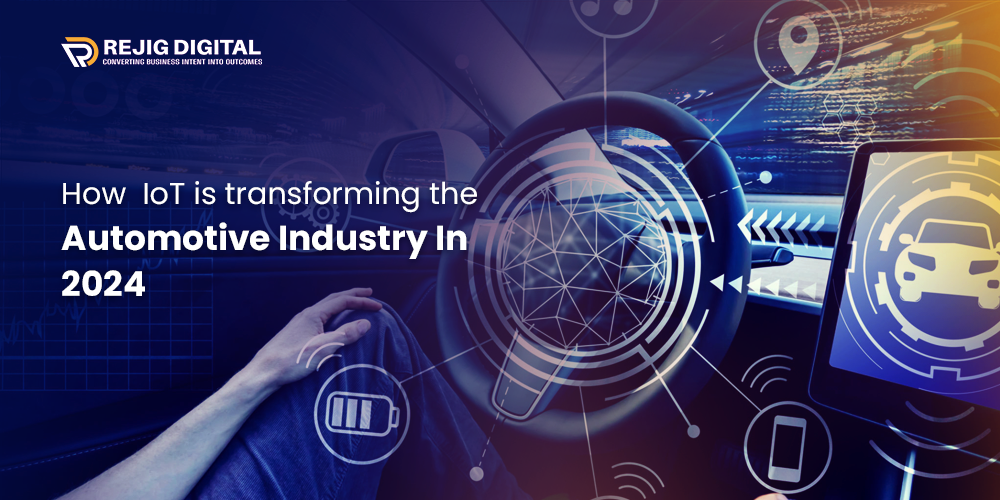The Internet of Things (IoT) has revolutionized the way we live, work, and businesses function. And IoT in automotive industry is no exception. The potential of IoT-powered devices and systems is empowering businesses to create seamlessly connected operations.
By leveraging the power of the IoT ecosystem, the automotive industry is able to make vehicles smarter, safer, and more efficient, bringing a new level of convenience and comfort to drivers. By knowing the strengthens of IoT, automotive businesses are embracing this leading technology in the form of different solutions, applications and software.
In this article, we’ll explore four amazing applications of IoT in the automotive industry that are transforming the way we drive. From predictive maintenance to connected navigation, these cutting-edge technologies are changing the game and making our lives easier and more convenient. Whether you’re a tech enthusiast, an automotive professional, or simply someone who loves to stay ahead of the curve, you won’t want to miss these exciting developments in IoT and the automotive world.
5 Groundbreaking Applications of IoT in Automotive Industry

1) Predictive Maintenance System
Predictive maintenance, a data-driven approach, enables the vehicle manufacturing industry to predict when parts or systems are likely to fail and when any abnormal situation will occur. By reducing unexpected breakdowns, increasing safety, and reducing costs, IoT-based predictive maintenance systems are transforming how car owners handle vehicle maintenance in the automotive industry.
This solution collects data about vehicles from a variety of sources, including sensors and vehicle telematics, and analyzes it to determine when parts or systems are likely to fail. For example, a predictive maintenance system may detect unusual wear and tear on a vehicle’s brake pads, alerting the driver to schedule maintenance before the problem becomes serious.
Report by Market Research Future (MRFR): Predictive Maintenance Market to Hit USD 111.34 Billion by 2030, with a CAGR of 26.2%
Key Benefits of Predictive Maintenance System
- Prevents Breakdowns
- Reduces Costs
- Improves Safety
- Minimizes Downtime
- Enhances Performance
- Provides Real-time Data
- Aids Decision Making.
2) Connected Navigation System
Connected navigation systems in the automotive industry are designed with the main aim of providing drivers with real-time information and assistance while on the road. As this modern system developed by utilizing the power of IoT in automotive industry which allows drivers to access and get updated traffic information, alternate route suggestions, and other useful data. This helps drivers to make informed decisions and navigate to their destination more efficiently, safely, and comfortably.
Connected navigation applications are integrated with other connected devices, such as smartphones and GPS systems, making it easier for drivers to access the information they need. For example, a driver can use their smartphone to access traffic updates and alternate route suggestions in real-time, even if they are not currently in the car.
Key Benefits of Connected Navigation System
- Real-time Traffic Updates
- Alternate Route Suggestions
- Increased Convenience
- Efficient Navigation
- Enhanced Comfort
- Accurate Information
- Smarter Driving Experience.
3) Fleet Management Software
In the automotive industry, fleet management software is used to monitor and optimize a company’s vehicle fleet’s performance and efficiency. This advanced software provides fleet managers with real-time visibility into their fleet’s operations, including tracking vehicles, monitoring fuel consumption, and planning routes.
Maintaining vehicle maintenance schedules, renewing licenses and insurance, and tracking other important details can also be done with fleet management software. It is possible to reduce operational costs, improve safety, increase productivity, and make better use of resources when companies use fleet management software.
The software is usually web-based and can be accessed from any device with an internet connection, making it easy to use and accessible to businesses of all sizes. As per the market research, by 2029, the global fleet management software market is projected to reach $67.38 billion, growing at a compound annual growth rate of 18.3%.
Key Benefits of Fleet Management Software
- Improved efficiency
- Better utilization
- Enhanced safety
- Increased productivity
- Streamlined maintenance
- Compliance management
- Real-time data/reporting
4) Connected Cars
The concept of connected cars is not new for the automotive industry and for us. According to research by Gartner, by the end of 2020, there were approximately 250 million connected cars. Connected cars through utilizing IoT in automotive industry widely known as CV2X (cellular vehicle to everything).
Additionally, the global market for connected cars, which was estimated to be worth $63.03 billion in 2019, is anticipated to grow to $225.16 billion by 2027, representing a CAGR of 17.1%.Connected cars are developed with the purpose of facilitating connectivity on wheels to bring more comfort, security and safety along with powerful technology.
Key Benefits of Connected Cars:
- Improved safety
- Enhanced security
- Better maintenance
- Improved data analysis
- Better driving experience
5) Digital Manufacturing – Industry 4.0
As the digital transformation is enhancing constantly and unlocking the possibilities of different businesses. In order to meet all the demands of different companies and ensure to meet the steps with success, we understand your requirements and customised solutions as per your needs.
We launch technology driven solutions that are powered by the combination of data analytics, Artificial Intelligence, Internet of Thing, and many more that help automotive businesses to track real time tracking of important KPI across LOB i.e. BS6 Compliance – Poka-yoke, Productivity, CBM, Quality, Energy, Operator & Traceability.
Other Benefits are –
- Traceability of components
- Operator compliance with Standard Operating Procedures (SOPs)
- Overall equipment effectiveness (OEE)
- Number of vehicles produced
- Specific energy consumption and Energy costs
- Operator skill violations
- Warnings and control limit violations for condition-based maintenance (CBM) parameters
- Tool life reporting are all crucial metrics for production performance monitoring and assessment.
- Comparing plan vs. actual performance allows for the most accurate assessment.
We focus to understand your business objectives, collaborate to solve difficulties, recognize any technological deficiencies, and ultimately deliver remarkable outcomes. Our strategy allows our clients to reach success.
Also Read: Smart IoT Solutions for Chemical Industry: A Worthwhile Investment
Concluding Lines on IoT in Automotive Industry
Just like other revolutionizing technologies, the Internet of Things holds a high percentage in the graph of transforming the automotive industry. IoT in the automotive industry enables vehicle manufacturers to provide better customer experience, and safety and enhance customer retention rates seamlessly.
Are you looking for the right digital solution to modernizing your business day to day operations? Rejig Digital is here to help you as a trusted partner. Our experts hold expertise in analyzing the existing business processes, models and operations and deliver top-notch solutions that design with the support of emerging technologies such as IoT, AR and others.




